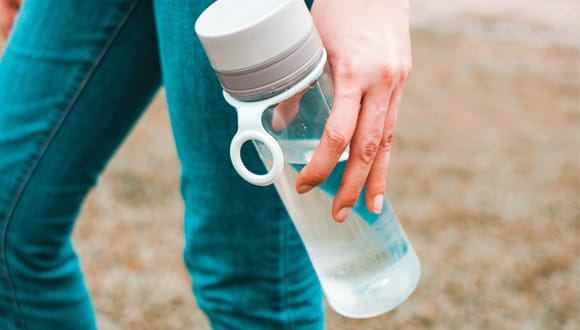Are You Washing Your Water Bottle Enough? (Plus, 5 Tips for Keeping a Clean Water Bottle)
March 16, 2022 - Katie McCallumHaving water always at hand is certainly a healthy habit to have, and your water bottle helps make that possible.
But for every time you've filled your bottle, how many times have you actually cleaned it? Or rinsed it even?
True, it's just water in there. Nothing should really be growing ... right? To that, I say, look no further than a moldy shower tub to find the answer.
Can you get sick from not washing your water bottle?
Thanks to public water sanitation, you're unlikely to get sick from the drinking water that comes out of your tap. But that doesn't mean the vessel in which you carry that water can't lead to problems of its own.
For starters, germs are everywhere — in the air, surfaces, your hands. Coincidentally, your water bottle probably goes almost everywhere with you, including the gym and to school or the office.
What's more, the moist, warm and sometimes dark environment within the bottle is a great place for germs to live.
Then there's the issue of backwash, wherein some of the fluid you drink flows out of your mouth and back into your bottle. This is problematic since saliva contains nutrients that can help germs in your bottle not only survive but thrive.
Lastly, we don't really treat our water bottles like we do other pieces of dishware, such as drinking glasses. Once you've downed all of the water, you simply fill the bottle back up — whereas an empty drinking glass would end up in the dishwasher, or rinsed and on the drying rack at the very least.
So, it's not hard to see how your water bottle might, over time, become ... germy.
In fact, a 2017 study examining the cleanliness of 90 participants' reusable water bottles found that 60% contained more bacteria than what's allowed in public drinking water — an indication that, yes, an unwashed water bottle could very well be a breeding ground for germs.
Still, not all microbes are bad for your health. (Saccharomyces cerevisiae, the yeast used to brew beer and wine, is proof of that.)
So were these germs ones that could actually make participants sick?
This is a bit trickier to answer, but the study found that almost a quarter of participants' bottles exceeded the total coliform bacteria count that regulatory agencies use as an indicator of whether potentially harmful germs might be present. To be clear, this isn't direct evidence that participants could've gotten sick from the germs in these bottles, but it suggests that harmful ones certainly could have been present — enough to unsettle you about neglecting the cleanliness of your water bottle.
How often should you clean your water bottle?
The safest answer? As often as you wash drinking glasses — every day.
Many water bottles are dishwasher-safe, so cleaning your bottle is sometimes as simple as running it through the wash. You'll want to check the label, though, since not all bottles are meant for the dishwasher. If yours isn't, simply wash it with warm, soapy water, rinse it well and set it on a rack to dry.
5 tips for keeping a clean water bottle
Now that you know you should keep your water bottle clean, here are a few tips:
1. Pick a bottle that's easy to clean
There are numerous types of water bottles to choose from these days, but due to hard-to-reach crevices, narrow openings, intricate lid designs or straws, washing them isn't always as simple as it sounds.
Just know that a narrow mouth in a bottle can prevent water and detergent from adequately reaching its interior surfaces. In addition, bottles with built-in straws, bite valves or sliding lids can be difficult to clean efficiently.
In general, the wider the mouth and simpler the design, the easier a water bottle will be to clean.
2. Be sure to clean all the pieces
No matter what type of water bottle you have, be sure that all of it gets cleaned — lid, straw and exterior included.
Speaking of cleaning a straw, consider investing in a straw brush and using it to scrub the interior of the straw with warm, soapy water.
3. Get a second bottle
If you're going the dishwasher route but really want your bottle at hand 24/7, invest in another one (or even a third, if you don't run your dishwasher every day) — swapping in a clean bottle each day.
4. Avoid putting anything other than water in your bottle
If you use your bottle for coffee, tea, a sports drink, soda, juice or something else that's not plain water, it's even more important to make sure that you don't neglect the bottle's hygiene.
These beverages can contain nutrients that make it even easier for germs to survive and grow.
5. Know if it's time for a more intense cleaning
If you've never cleaned your water bottle or if it's been longer than you'd like to admit since you last cleaned it, you may consider starting with a vinegar-based deep clean.
How to clean your water bottle using vinegar:
- Make a diluted vinegar solution by mixing 1 part distilled white vinegar with 4 parts water.
- Fill the bottle with the vinegar solution, shake vigorously and let soak overnight. (Don't forget to soak any other pieces, such as lids or straws, in the vinegar solution overnight as well.)
- Dump the vinegar solution and rinse the bottle and any other pieces with water.
- Let the bottle and other pieces air dry on a clean dry rack.








